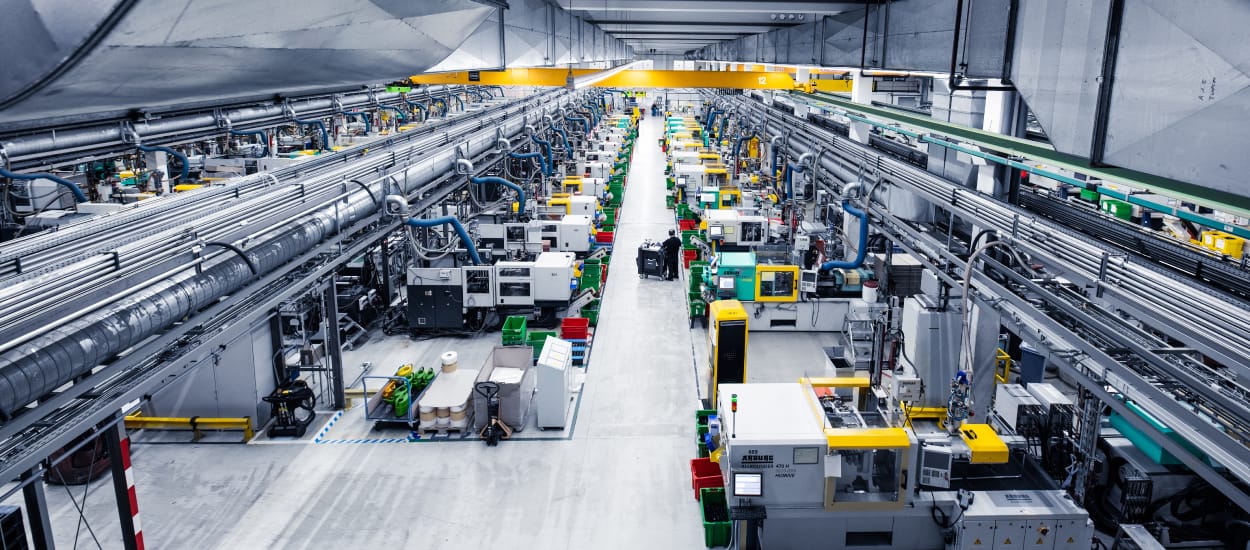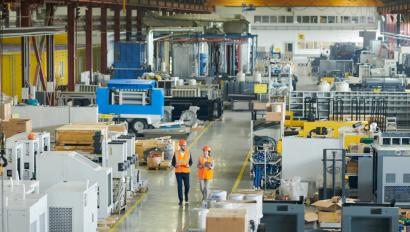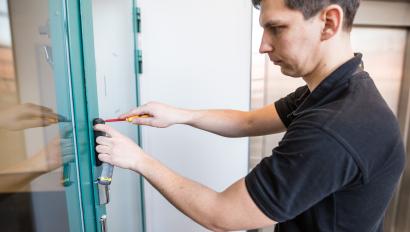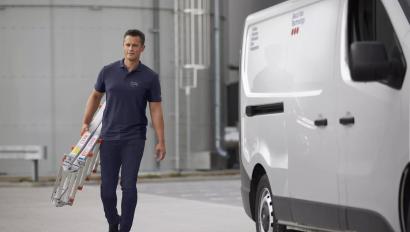Powering a Vital Industry: Technology that Helps Keep the World Moving

Manufacturing and logistics companies faced an exceedingly challenging year in 2020 and have adapted to security threats both new and familiar.
Fraudulent activities, such as internal and external theft, and unauthorized facility access are still relevant concerns in manufacturing and logistics facilities. The challenges before COVID-19 continue factoring into a facility’s comprehensive security plan.
However, now they must also deploy new protective measures within their facilities, such as human temperature screening and increased social distancing between workers. New facility and product safety protocols require enacting new technologies and policies, especially with a potential need for contact tracing due to viral exposure.
All of this must also occur without affecting employee throughput — screening thousands of workers during a shift change must happen quickly and seamlessly.
Security will keep playing its traditional role in asset protection and threat mitigation. But, the new realities of this time mean security must enhance health and safety measures too.
This blog offers a deep dive on how (and what) technology can help manufacturing and logistics companies improve workplace health and safety, reduce supply chain costs, increase efficiencies and leverage data-driven insights.
Workplace Health & Safety
As the world changes, basic security needs like detecting and preventing theft persist. Employees will steal from their employers, and intruders will break into facilities and steal inventory. These types of threats have not dissipated during the COVID-19 pandemic, and they will likely remain with companies long afterward.
Security systems thrive in this traditional realm. Core technologies like video surveillance, access control, intrusion detection and alarm verification operate together to help detect and prevent unauthorized access by intruders and better monitor and control for suspicious activity.
For workplace safety, security solutions can help protect your company from incidents, such as the following:
Fraudulent Activity
According to the Association of Certified Fraud Examiners, organizations lose 5% of annual revenue to fraudulent activity, and the median loss per case of fraudulent activity for manufacturers is $198,000. Both employee and intruder theft pose not only risk of economic loss but also endanger workplace safety.
Security systems like video cameras can assist in deterring theft. Cameras placed in storage locations or inventory staging points where products could be stolen can capture thieves in the act. Paired with an access control system, managers can pinpoint who exactly entered specific storage areas and use that information to pursue investigations.
Sometimes, expensive machinery, pallets of goods or other large assets may need to be stored outside, where they become high-value targets for thieves. Perimeter cameras, especially those equipped for thermal imaging, can safeguard a large outdoor lot when employees are not present. Even in the darkest settings, these cameras can pick up images and determine if a presence is human or not — the difference between a dog prowling the lot and a thief stealing your goods. That difference can help reduce false alarm rates and prevent incurring subsequent fines from local authorities.
These cameras can record video to locally-held storage or over cloud-based networks as records of unauthorized activity. While an employee might try to destroy video footage kept on-premises if they know where it’s stored, cloud-based storage can be much tougher for them to access. Cameras can also be paired with 24/7 monitoring center services as part of a larger protection plan, wherein authorities can be dispatched night or day to stop a crime in progress.
Unauthorized Facility Access
An important aspect of deterring theft is to prevent unauthorized access to your facilities in the first place. Whether it’s an employee going where they shouldn’t be or an outside intruder breaking in, video surveillance solutions can capture and record visual evidence of their activity. They often work alongside intrusion detection systems to monitor for unauthorized activity.
Intrusion detection relies on microphones, cameras and motion-triggered devices to produce audio- and video-based notifications of a break-in, which can then be investigated. Depending on a facility’s size, detection devices could be placed at strategic points, like entryways, or spread across the entire location.
These technologies can detect specific sounds like glass breaking or capture human-shaped objects on-camera, which then triggers alerts to the facility owner. Paired with a 24/7 monitoring solution, you can be notified of potential break-ins or other suspicious activity at a moment’s notice.
Monitoring center staff can also verify audio and video to confirm a break-in is occurring and notify authorities. They can even provide detailed information like a description of the perpetrator and if they’re armed. Alarm verification can lead to much faster response times from law enforcement and assist authorities in apprehending offenders.
Video surveillance can also provide protection across your premises. For example, cameras mounted on exterior walls or on lampposts in parking lots can survey an entire location. Employees can feel safer during shift changes as they head to their cars in the parking lot. Unauthorized activity can be captured on video, stored on your own systems or in cloud-based solutions and categorized for evidentiary purposes. And, by installing visible cameras externally, companies can potentially deter intruders from the start.
Chain of Custody
Preventing fraudulent activities are surely top of mind for many facility owners, but security systems can also protect them from other threats. For example, ensuring a product’s chain of custody is paramount within the manufacturing industry. That also translates into concern that products, both raw and finished, could end up mishandled, mistreated or otherwise have an inconsistent chain of custody.
Integrating video surveillance with access control systems can help allay these fears and create a stronger, verified chain of custody. For example, in a case where a product may have been mishandled:
- Facility managers can use an access control solution to lock out unauthorized employees from locations where they could touch or handle certain materials or products.
- Managers can create an on-demand audit trail to show who entered what part of a facility and determine who handled the products.
- Managers can review camera footage to witness the actual handling of a product, where it was taken, who else possessed it and other issues that could arise from mishandling.
These solutions can help preserve chain of custody and protect workplaces from incidents potentially damaging to the bottom line or to their reputation.
Site Occupancy Management
The COVID-19 pandemic has brought employee management within facilities to the forefront. What may have already been a concern with occupancy and optimizing placement of employees on the floor has now become a crucial step in protecting workers’ health. The larger the facility, the more difficult it becomes to coordinate capacity within it.
Access control systems can assist facilities in site occupancy management. People counting systems can track employee entry and exit and update counters in real-time. Integrated health screening questionnaires and touchless temperature and mask screening technology also support rapid entry and check for adherence to the latest health and safety guidelines. If workers do still get sick, these systems produce an auditable trail to help contact tracers determine potential points of infection.
Once employees are inside the facility, it’s important to help them stay healthy. Instead of managers walking the floor — another potential issue in the age of social distancing — video surveillance solutions can perform much of the monitoring for managers. With footage and data concentrated in a single hub, managers can reposition workers, machinery and other items on the floor to better promote social distancing and ensure capacity limits are met safely.
Supply Chain Costs and Efficiencies
While workplace health and safety will always be a top priority, modern security solutions go beyond threat detection and mitigation. New technologies enable companies to plan proactively and make adjustments to improve supply chain costs and efficiencies, ultimately contributing to a stronger return on investment.
Throughput Management
Previously, facilities had numerous entrance and exit points available for use. However, changing policies and the recent need to restrict people flow has turned facility entry into a choke point and top concern for manufacturers. Especially important is how to manage the flow of workers during high-volume times like shift changes. Crowded entryways prevent social distancing, and long lines and slow processes can mean greater risk of coming in contact with others and spreading germs. Additional measures like human temperature screening technology are key to creating a safer, healthier environment, but without smart planning around them, they may negatively affect your facility’s efficiency at a time when high productivity is needed most.
Innovations like automated screening technology, touchless devices and seamless policies and protocols make the difference. An integrated, advanced screening solution enables workplaces of all sizes to improve operational efficiency, foster a healthier environment and help reduce liability risks by automating the screening process and policies for both visitors and staff.
Paired with other access control technologies, facility entry can occur much faster than before. Automated, touchless visitor screening can pre-empt many potential issues and produce credentials to admit workers and visitors more efficiently. Integrated human temperature screening can capture worker health data in seconds and allow or prevent entry as needed. Incorporated analytics keeps the whole system moving efficiently, notifying the right people across departments whenever issues arise.
Automating Facility Processes
Budgets are always a concern, but in the age of COVID-19, saving time and money matters more than ever. In addition to protecting your current assets, security systems can help managers locate more opportunities for cost savings through automated processes.
For example, one manufacturing company is now using GPS technology to track forklift movement throughout their facilities. This technology is automating routing to help them save time between tasks. GPS technology not only tells managers where forklifts are but generates data and insights on how to use them better, saving time and money overall.
Other companies are deploying solutions to make access an easy, seamless process. Automated and touchless screening can help facilitate entry and exit into buildings. Employees can take health screening questionnaires before arrival and receive a QR code invite to enter the building, helping further mitigate health and safety risks while reducing costs.
Labor and Expense Optimization
Automation also supports optimization of other labor and expense centers within the facility. Expenses for security, in particular, can accumulate quickly: responding to false alarms, armed guards to patrol facilities inside and out, and system management and maintenance all present costs to your facility. Automated solutions focused on video surveillance cut down on these unnecessary expenses by streamlining surveillance through a single system to monitor and help verify potential threats.
Security solutions can also support increased productivity from labor on the floor. Using interior video surveillance cameras beyond employee theft deterrence, facility managers can monitor high-traffic areas, helping to enforce social distancing protocols or correct usage of personal protective equipment.
Also, when it comes to workers’ compensation claims, being able to verify employee behavior or identify opportunities for additional training measures can reduce fines and improve long-term workplace behaviors.
Data-Driven Security Decisions
Companies are leveraging security data now more than ever to gain insights into their operations and drive efficiencies. Today’s networked and cloud-based solutions simplify how organizations harness this data through artificial intelligence and machine learning.
Optimization with Advanced Analytics
In the course of their work, security systems capture incredible amounts of metadata which, when analyzed using AI- and machine learning-powered systems, can produce insights otherwise missed.
For example, data from camera footage of workers throughout a facility can be overlaid onto a facility map to produce a “heatmap.” This shows managers the “hotspots” — the places where workers congregate the most or choke points where people constantly come in close contact — informing them on how to rework their floor plan.
Beyond the pandemic, security data analytics can assist managers in identifying and eliminating points of inefficiency on product lines or anywhere throughout the value chain. It’s all about collecting data and delivering it in easy-to-digest formats, where managers can then make smarter decisions around operations, compliance, device status, threat level and more. That kind of visibility into company health can mean the difference for a company’s survival today and ability to thrive tomorrow.
Data Governance
All these new technologies generate mountains of data — which means your policies around using and securing that data may need an upgrade, too. Protecting data and networks is increasingly important: The World Health Organization reported a fivefold increase in cyber attacks since the COVID-19 pandemic began, and phishing attacks have ballooned by 600% since February 2020. Hacked or mishandled data, especially of a personal nature, can have serious legal and financial consequences for affected companies. And, as security systems rely more on collecting and using increasingly sensitive data, safeguarding that data matters more than ever.
Manufacturers will first need to determine their responsibilities with respect to protecting personally identifiable information (PII) like worker health data. Depending on the type of data gathered, companies may need to obtain consent from their workforce and visitors, as well as provide disclosures on how they plan to use and store their data. Companies should also tighten their control over data governance by developing and enforcing policies identifying who has access to security data, where it’s stored, when and who is encrypting it and how it’s used. Clear policies and procedures offer more comprehensive protection not only for workers’ information but also for security teams, managers and other company personnel responsible for data management.
Evolving Threats Require Modern Security Solutions
The COVID-19 pandemic undoubtedly introduced new threats for manufacturing and logistics companies. But, it also exacerbated other rising threats like cybersecurity and fraudulent activity. Coupled with the need to increase efficiency and better ensure resiliency in an uncertain climate, modern security solutions are critical now more than ever.
For companies ready to take the next step toward creating a safer, healthier and more efficient environment, working with a trusted security partner can help you solve your short-term challenges as well as plan a long-term strategy for building a robust security program scalable with your facility’s growth. Expert advice, a combination of traditional and advanced security solutions like access control, video surveillance, monitoring and AI-powered analytics, and a clear implementation and maintenance plan can prepare companies to combat new threats and streamline operations to mitigate risks, remain resilient and progress.
Disclaimer: By using the Blog section of this website (“Blog”), you agree to the terms of this Disclaimer, including but not limited to the terms of use and our privacy policy. The information provided on this Blog is for information purposes only. Such information is not intended to provide advice on your specific security needs nor to provide legal advice. If you would like to speak to a Security representative about your specific security needs, please contact us.























